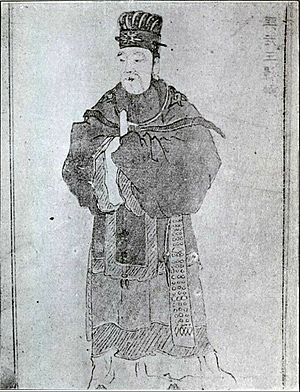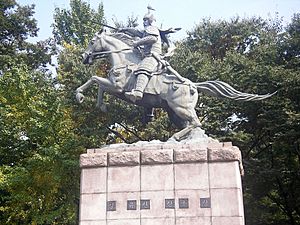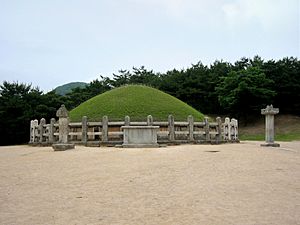Gim Yu-sin facts for kids
| Gim Yu-sin | |

Portrait of Gim Yu-sin in the "famous portrait photo book of Joseon" published in 1926
|
|
Quick facts for kids Korean name |
|
|---|---|
| Hangul |
김유신
|
| Hanja | |
| Revised Romanization | Gim Yu-sin |
| McCune–Reischauer | Kim Yu-sin |
Gim Yu-sin (born in 595, died August 18, 673) was a famous Korean military general and leader in the 7th century. He lived during the Silla kingdom. He played a key role in uniting the Korean Peninsula under Silla's rule. This happened during the time of King Muyeol and King Munmu.
Gim Yu-sin was believed to be the great-grandchild of King Guhae of Geumgwan Gaya. King Guhae was the last ruler of the Geumgwan Gaya state. This important family background gave Gim Yu-sin a high position in Silla's special "bone rank system." This system decided a person's social and military standing. Most of what we know about Gim Yu-sin comes from old Korean books. These include the Samguk Sagi and the Samguk Yusa.
Contents
Early Life and Training
Gim Yu-sin was born in 595 in a place called Manno county. This area is now known as Jincheon County. His father was General Gim Seohyeon. His mother was Lady Manmyeong. She was the daughter of Gim Sukheuljong, who was the younger brother of King Jinheung of Silla.
Gim Yu-sin became a Hwarang warrior when he was just 15 years old. Hwarang were young, elite warriors in Silla. They were known for their bravery and skill. By the age of 18, he was a very good swordsman. He also became a Gukseon, which means a leader of the Hwarang.
By 629, when he was 34, Gim Yu-sin was put in charge of all of Silla's armed forces. Three years later, his cousin, Princess Deokman, became Queen Seondeok of Silla. She kept Gim Yu-sin as the main commander of the royal army. During Queen Seondeok's rule (632–647), Gim Yu-sin had many private soldiers. He won many battles against the kingdom of Baekje. He became one of the most powerful people in Silla.
Great Military Victories
Gim Yu-sin's first big military command was around 629 AD. He quickly showed how skilled he was as a warrior. Silla was always fighting with its neighbor to the west, Baekje. They fought over land, and the struggle lasted for many years. During this time, Gim Yu-sin became a general. He was a very skilled leader on the battlefield.
At one point, Baekje and Silla had teamed up to fight against Goguryeo. Goguryeo was a powerful kingdom that wanted to expand south. Together, Silla and Baekje attacked Goguryeo. Silla took the northern land, and Baekje took the land south of the Han river. But then, Silla broke their agreement. Silla attacked Baekje to take both areas for itself. After this, Baekje became friends with Goguryeo.
In 655, Goguryeo and Baekje attacked Silla. Silla then joined forces with Tang dynasty China to fight them. Gim Yu-sin was definitely leading the Silla army by this time. In 660, with 50,000 Silla soldiers and about 130,000 Tang soldiers, Gim Yu-sin attacked the Baekje capital, Sabi. This was one of the most famous battles of that century, called the Battle of Hwangsanbeol.
The Baekje army was led by General Gyebaek. But his forces had only about 5,000 men. They were no match for Gim Yu-sin's warriors, who were about ten times as many. Baekje was already having problems inside its own government. So, it quickly fell apart.
Gim Yu-sin's Silla forces and their Tang allies then moved on Goguryeo. In 661, they attacked the strong Goguryeo kingdom. They were pushed back at first. But the attack had made Goguryeo weaker. In 667, another attack was launched. In 668, Goguryeo was finally defeated.
Silla still had to deal with some groups that resisted. But their main goal was to make sure their Tang allies left the peninsula. After some difficult fights, Silla finally forced the Tang troops to leave. This united the entire peninsula under Silla's rule.
Amazing Stories
Many stories are told about Gim Yu-sin. One story says he was told to stop a rebel army. But his soldiers refused to fight. They had seen a large star fall from the sky. They thought this was a bad sign. To make his troops brave again, the General used a large kite. He tied a fire ball to it and sent it into the sky. The soldiers saw the "star" return to heaven. They felt confident again and defeated the rebels.
Another story tells how General Gim cleverly used kites. He used them to send messages between his troops. This happened when his army was split between islands and the mainland.
His Later Years
Throughout his life, Gim Yu-sin believed that Baekje, Goguryeo, and Silla should not be separate countries. He wanted them to be united as one. He is seen as the main person who brought the Korean Peninsula together. He is the most famous general from the unification wars of the Three Kingdoms.
Gim Yu-sin was greatly rewarded for his efforts. In 668, King Munmu gave him a special title, Taedaegakgan. This was like "Supreme Herald of Defense." He also received a village with over 500 households. In 669, he was given about 142 separate horse farms across the kingdom. He died four years later, leaving behind ten children.
Gim Yu-sin lived to be 79 years old. He is known as one of the greatest generals and masters of Korean swords in Korean history. Many stories and legends are about him. Most Koreans know about him from a young age. After he died on August 18, 673, General Gim was given the honorary title of King Heungmu. He was buried at the foot of Songhwa Mountain, near Gyeongju in southeastern Korea. His tomb was as grand as a king's.
His Family
Gim Yu-sin had two sisters, Gim Bo-hee and Gim Mun-hee. Gim Mun-hee later became Queen Munmyeong. She married Yushin's friend, Gim Cheon-chu. He became King Taejong Muyeol of Silla. King Muyeol is known for leading the unification of the Korean peninsula under Silla. Muyeol and Munmyeong were the parents of King Munmu of Silla and Gim Inmun.
Gim Yu-sin's third wife, Lady Jiso, was the third daughter of King Muyeol of Silla. Gim Yu-sin had ten children. His second son, Gim Won-sul, later helped Silla become fully independent from the Tang dynasty.
- Wife: Lady Jiso, daughter of King Muyeol of Silla and Queen Munmyeong
- Son: Gim Sam-gwang (김삼광)
- Son: Gim Won-sul (김원술)
- Son: Gim Won-jeong (김원정)
- Son: Gim Jang-yi (김장이)
- Son: Gim Won-mang (김원망)
- Daughter: Lady Gim of the Gimhae Gim clan (김해 김씨)
- Daughter: Lady Gim of the Gimhae Gim clan (김해 김씨)
- Daughter: Lady Gim of the Gimhae Gim clan (김해 김씨)
- Daughter: Lady gim of the Gimhae Gim clan (김해 김씨)
What He Left Behind
Today, Koreans remember Gim Yu-sin as one of the greatest generals in their history. His most important achievement was uniting the Korean nation for the first time. One of his ten children, his second son Gim Won-sul, also became a general. He was important in helping Silla become united.
A shrine called Jincheon Gilsangsa is dedicated to his portrait. It is located in Jincheon-eup, Jincheon-gun, Chungcheongbuk-do.
Gim Yu-sin in Pop Culture
Gim Yu-sin has appeared in many TV shows and games:
- He was played by Yoon Seung-won, Lee Jong Soo and Lee David in the 2006–2007 SBS TV series Yeon Gaesomun.
- He was played by Uhm Tae-woong and Lee Hyun-woo in the 2009 MBC TV series Queen Seondeok.
- He was played by Park Sung-woong in the 2011 MBC TV series Gyebaek.
- He was played by Kim Yu-seok and Noh Young-hak in the 2012–2013 KBS1 TV series The King's Dream.
- He appeared in the Korean online game Atlantica Online as a playable character called Hwarang.
- He was played by Jang Tae Wong in the 2017 KBS TV series Chronicles of Korea.
- He is also in the 2021 WEBNOVEL called QUEEN JINDEOK by author GLORIAN.C.REGNARE.
See also
 In Spanish: Kim Yushin para niños
In Spanish: Kim Yushin para niños
- Korean history
- Three Kingdoms of Korea
- Queen Seondeok (TV series)



